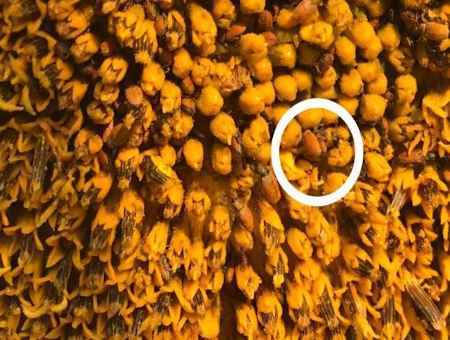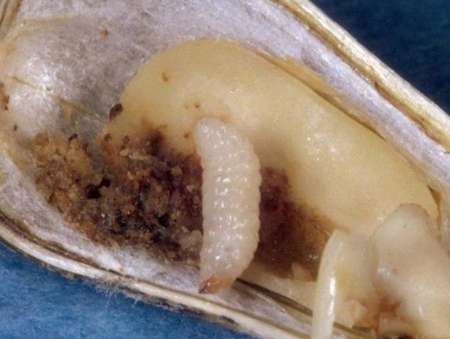Identification
Red sunflower seed weevil adults are relatively small beetles (1/10 to 1/8 of an inch long) that are a reddish-brown color. Like other weevils, they have mouthparts that extend forward beyond the head and form a snout (Figure 1). The antennae originate on this snout.
Red sunflower seed weevil adults are often present in fields prior to flowering, but they will move to the heads once flowering begins (Figure 2). Larvae of the red sunflower seed weevil are cream colored and relatively small. However, the larvae are not typically observed as they feed directly on the developing seed (Figure 3).

Figure 2. Red sunflower seed weevils on the florets of a sunflower.

Figure 3. Red sunflower seed weevil larva.
Scouting
Scouting for red sunflower seed weevils should begin when the yellow ray petals are visible on the face of the developing bud (R4 growth stage) and continue until 70% of pollen shed has occurred (R5.7 growth stage). Once the majority of the sunflowers in the field have reached R5.7, most egg-laying has finished, and the seeds are too mature to be suitable for further red seed weevil egg oviposition.
To scout for red sunflower seed weevils, walk approximately 75 feet into the field and examine five random plants. Next, walk to another location approximately 75 feet from the first and scout an additional five plants. Repeat this process until a total of 25 sunflower plants have been examined in the field. Developing heads can be examined by simply rubbing the face of the head to disturb the weevils and make them easier to count. If this method doesn’t work, they can also be scouted for by using an aerosol insect repellant, which is sprayed across the head. After spraying, simply wait for the beetles to begin to emerge and count them. Once all the plants have been examined, calculate the average number of red sunflower seed weevil adults per plant, present in the field.
Economic Threshold and Management
For red sunflower seed weevils, the economic threshold is dependent on the value of the crop, cost of insecticide management, and the planting population of the sunflower. Generally speaking, for most oilseed sunflower varieties, the economic threshold for red sunflower seed weevils is 4-6 adults per sunflower head. For confection sunflowers, the economic threshold is 1 red sunflower seed weevil per head. Ideally, management of the red sunflower seed weevil populations should also reduce other pests including the banded sunflower moth, sunflower moth, and tarnished plant bug.
For a list of insecticides currently labeled for red sunflower seed weevil management please refer to the latest South Dakota Pest Management Guide: Alfalfa and Oilseeds.
Since management of the red sunflower seed weevil occurs during flowering, considerations should be made to reduce the potential impact of the spray on pollinators. It is best to treat in the morning or evening when pollinators are least active. To determine if hives are nearby, please refer to Field Watch and register as an applicator.
Source : sdstate.edu